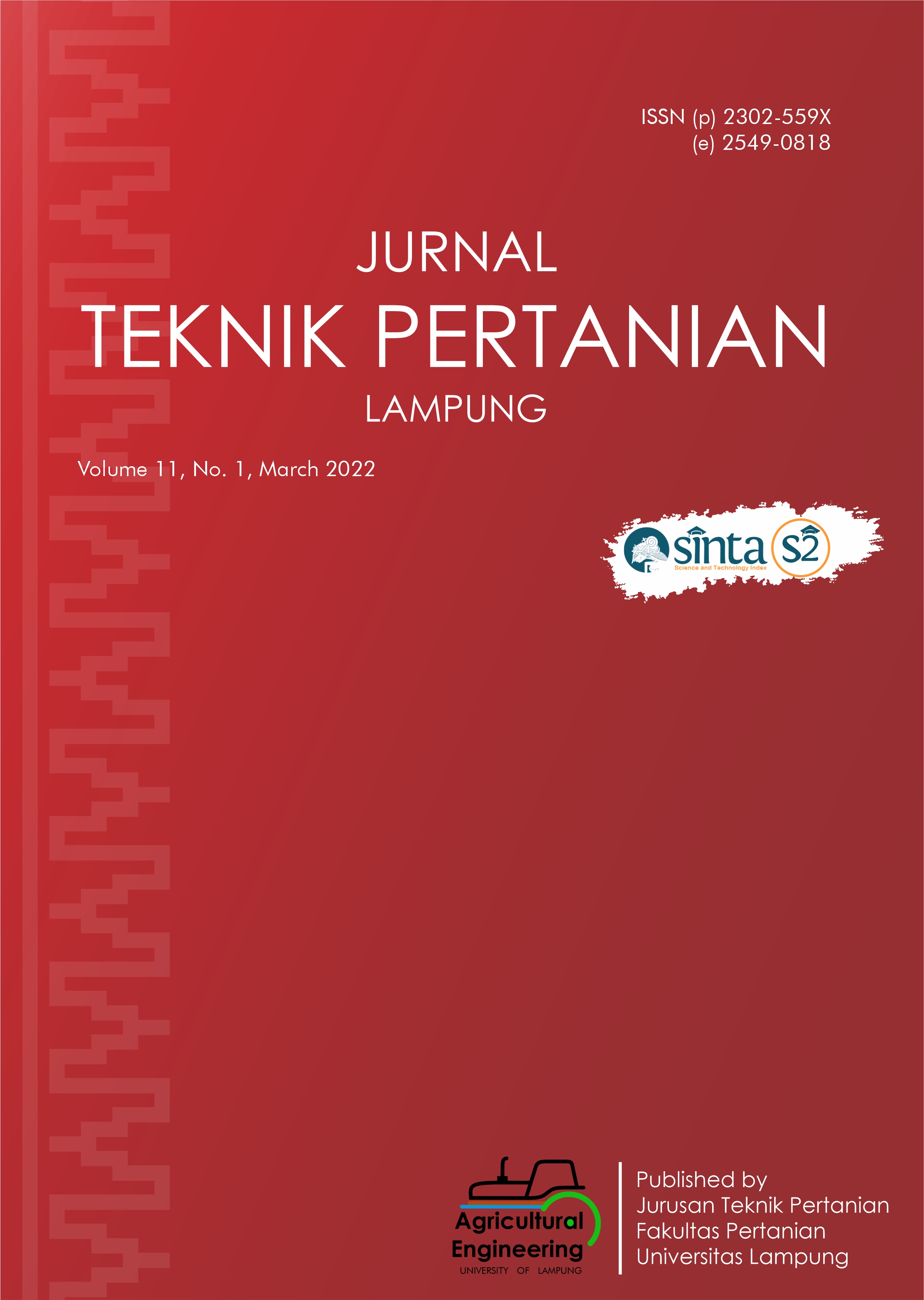Analysis of Mulching Effects on The Growth Performence of Spring Onion Freda Variety (Allium fistulosum L.)
DOI:
https://doi.org/10.23960/jtep-l.v11i1.110-116Abstract
The use of mulch aims, among others, to provide a more ideal microclimate to support the growth of spring onion. The purpose of this study was to analyze the effect of mulch on the growth performance of the spring onion Freda Variety. The research location was conducted at the Salaran Experimental Garden belonging to the SWCU Agriculture and Business Faculty from May 2021 to August 2021. This experiment used RAK which consisted of five treatments, namely M0 (without mulch), M1 (black-silver plastic mulch), M2 (transparent plastic mulch), M3 (corn stem mulch), M4 (reed mulch). Each treatment was repeated five times and the data were analyzed using variance and DMRT 5%. The result showed that the best treatment to support spring onion performance was reed mulch because it had the highest average of all growth components and plant fresh weight of 53,17 cm, stem diameter 14,92 mm, number of leaves 6,50 leaves, number of tillers 1,90 and fresh weight 441 grams and has the highest soil organic matter content, lower temperature soil and increase soil moisture.
Keyword: Reed, Corn stem, Spring onion, Plastic mulch, Mulching
References
Antari, R., Wawan, W., & Manurung, G.M.E. (2014). Pengaruh pemberian mulsa organik terhadap sifat fisik dan kimia tanah serta pertumbuhan akar kelapa sawit. Jurnal Online Mahasiswa (JOM) Fakultas Pertanian, 1(1): 1–13.
Basuki, J., Yunus, A., & Purwanto, E. (2009). Peranan mulsa dalam meningkatkan pertumbuhan dan produksi cabai melalui modifikasi kondisi fisik di dalam tanah. Partner, 16(2): 73–77.
BPS. (2020a). Luas Panen Tanaman Sayuran Menurut Provinsi dan Jenis Tanaman. Retrieved 9 March 2022, from https://www.bps.go.id/indikator/indikator/view_data_pub/0000/api_pub/bxnvb1pmzndqudhkwelusjhzritidz09/da_05/1
BPS. (2020b). Produksi Tanaman Sayuran 2020. Retrieved Retrieved 9 March 2022, from https://www.bps.go.id/indicator/55/61/1/produksi-tanaman-sayuran.html
Dewi, E. S. (2013). Pengaruh pemberian mulsa organik terhadap pertumbuhan dan hasil tanaman tomat. Jurnal Agropet, 10(1): 28–34.
Fahrurrozi. (2018). Plastikultur: Penggunaan Mulsa Plastik untuk Produksi Tanaman Sayur. Yogyakarta: ANDI.
Alhadi, B. (2018). Pengaruh jarak tanam dan mulsa organik terhadap pertumbuhan dan hasil tanaman terung (Solanum melongena L.). Jurnal Warta, 56(April): 6 pages. DOI: https://doi.org/10.46576/wdw.v0i56.16
Harsono, P. (2012). Mulsa organik : Pengaruhnya terhadap lingkungan mikro, sifat kimia tanah dan keragaan cabai merah di tanah vertisol Sukoharjo pada musim kemarau. Jurnal Hortikultura Indonesia, 3(1): 35–41. https://doi.org/10.29244/jhi.3.1.35-41
Haryanto, A. (2015). Perpindahan Panas. Yogyakarta, Innosain: 421-422
Laude, S., & Tambing, Y. (2010). Pertumbuhan dan hasil bawang daun (Allium fistulosum L.) pada berbagai dosis pupuk kandang ayam. Agroland Jurnal Ilmu-Ilmu Pertanian, 17(2): 144–148.
Maulana, I. D., & Chodzin, M. . (2011). Penggunaan alang-alang untuk mengendalikan gulma dan meningkatkan produksi tanaman jagung (Zea mays L.) di lahan kering. Jurnal Sains Terapan, 1(1): 66–72. DOI: https://doi.org/10.29244/jstsv.1.1.66-72
Sabaruddin, S., Fitri, S.N.A., & Lestari, L. (2009). Hubungan antara kandungan bahan organik tanah dengan periode pasca tebang tanaman HTI Acacia mangium Willd. J. Tanah Trop, 14(2), 105–110.
Sutrisna, N., Ishaq, I., & Suwalan, S. (2003). Kajian rakitan teknologi budidaya bawang daun (Allium fistulosum L.) pada lahan dataran tinggi di Bandung, Jawa Barat. Jurnal Pengkajian dan Pengembangan Teknologi Pertanian, 6(1): 64–72.
Wisudawati, D., Anshar, M., & Lapanjang, I. (2016). Pengaruh jenis mulsa terhadap pertumbuhan dan hasil bawang merah (Allium ascalonicum Var. Lembah Palu) yang diberi sungkup. E-jurnal Agrotekbis, 4(2): 126–133.
Downloads
Published
Issue
Section
License
- Authors who publish with this journal agree to the following terms:
- Authors retain copyright and grant the journal right of first publication with the work simultaneously licensed under a Creative Commons Attribution-ShareAlike 4.0 International Lice that allows others to share the work with an acknowledgement of the work's authorship and initial publication in this journal.
- Authors are able to enter into separate, additional contractual arrangements for the non-exclusive distribution of the journal's published version of the work (e.g., post it to an institutional repository or publish it in a book), with an acknowledgement of its initial publication in this journal.
- Authors are permitted and encouraged to post their work online (e.g., in institutional repositories or on their website) prior to and during the submission process, as it can lead to productive exchanges, as well as earlier and greater citation of published work (See The Effect of Open Access).
Jurnal Teknik Pertanian Lampung

JTEPL is licensed under a Creative Commons Attribution-ShareAlike 4.0 International License.

